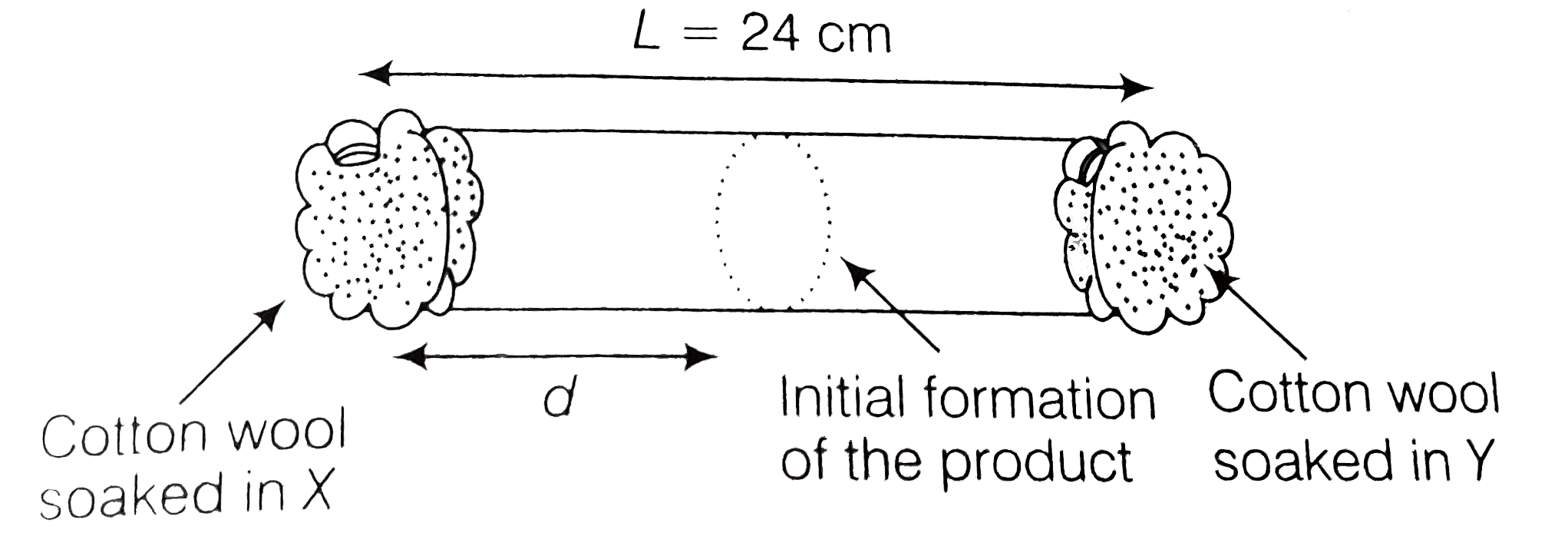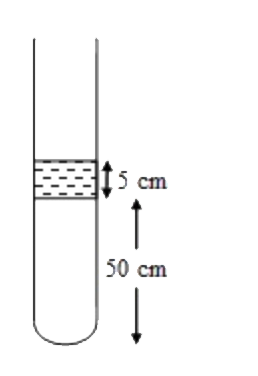X and Y are two volatile liquids with molar weights of 10gmol−1and40gmol−1 respectively. Two cotton plugs, one soaked in X and the other soaked in Y, are simultaneously placed at the ends of the tube of length L=24cm, as shown in the figure. The tube is filled with an inert gas at 1 atmosphere pressure and a temperature of 300 K. Vapours of X and Y react to form a product which is first observed at a distance from the plug soaked in X. Take X and Y to have equal molecular diameters and assume ideal behavior for the inert gas and the two vapours.

The value of d in cm (shown in the figure), as estimated from Graham’s law, is:
larger mean free path for X as compared to that of Y
larger mean free path for Y as compared to that of X
increased collision frequency of Y with the inert gas as compared to that of X with the inert gas
increased collision frequency of X with the inert gas as compared to that of Y with the inert gas
The correct Answer is:B, D
x is a lighter gas than y, hence x has greater molecular speed. Due to greater molecular speed of x, it will have smaller mean free path and greater collision frequency with the inert gas molecules. As a result, x will take more time to travel a given distance along a straight line. Hence x and y will meet at a distance smaller than one calculated from Graham’s law.
Topper's Solved these Questions
- STATES OF MATTERBOOK - VMC MODULES ENGLISHCHAPTER - STATES OF MATTEREXERCISE - ILLUSTRATION
30 Videos
- STATES OF MATTERBOOK - VMC MODULES ENGLISHCHAPTER - STATES OF MATTEREXERCISE - SOLVED EXAMPLES
20 Videos
- STATES OF MATTERBOOK - VMC MODULES ENGLISHCHAPTER - STATES OF MATTEREXERCISE - JEE-Main ( ARCHIVE )
17 Videos
- STATES OF MATTERBOOK - VMC MODULES ENGLISHCHAPTER - STATES OF MATTEREXERCISE - IMPECCABLE
50 Videos
- STOICHIOMETRY - IBOOK - VMC MODULES ENGLISHCHAPTER - STOICHIOMETRY - IEXERCISE - JEE Advanced (Archive)
31 Videos
Similar Questions
X and Y are two volatile liquids with molar weights of 10gmol−1 and 40gmol−1 respectively. Two cotton plugs, one soaked in X and the other soaked in Y, are simultaneously placed at the ends of a tube of length L=24 cm, as shown in the figure.
The tube is filled with an inert gas at 1 atm pressure and a temperature of 300K. Vapours of X and Y react to form a product whichh is first observed at a distance dcm from the plug soaked in X.
Take X and Y to have equal molecular diameters and assume ideal behaviour for the inert gas and two vapours.

The value of d in cm (shown in figure), as estimated from Graham's law, is
View SolutionX and Y are two volatile liquids with molar weights of 10gmol−1 and 40gmol−1 respectively. Two cotton plugs, one soaked in X and the other soaked in Y, are simultaneously placed at the ends of a tube of length L=24 cm, as shown in the figure.
The tube is filled with an inert gas at 1 atm pressure and a temperature of 300K. Vapours of X and Y react to form a product whichh is first observed at a distance dcm from the plug soaked in X.
Take X and Y to have equal molecular diameters and assume ideal behaviour for the inert gas and two vapours.

The value of d in cm (shown in figure), as estimated from Graham's law, is
View SolutionA vertical tube of length 100 cm contains a mercury pallet of length 5 cm as shown in the figure. The length of the tube above mercury pallet if the tube is inverted is nearly: (atmospheric pressure = 75 cm Hg of Hg)

View SolutionIn two containers X and Y same gas is filled. If the pressure, volume and absolute temperature of gas in X are three times as compared to that in Y and if the mass of X is mg, the mass of Y is
View SolutionThe surface tension of two liquids are 30 and 60 dyne cm−1 respectively. The liquid drop form at the ends of two tube of the same radius. The ratio of the weight of the two drops is
View SolutionA liquid of density ρ is filled in a U-tube is accelerated with an acceleration a so that the height of liquid in its two vertical arms are h1andh2 as shown in the figure. If l is the length of horizontal arm of the tube, the acceleration a is

View SolutionIf 42 g of an unknown gas X occupies a volume of 125 L at 0.3 bar pressure and 300 K temperature then the gas X could be :
View SolutionTwo liquids X and Y boil at 110∘C and 130∘C, respectively. Which one of them has higher vapour pressure at 50∘C?
View SolutionA sample of helium and neon gases has a temperature of 300K and pressure of 1.0atm. The molar mass of helium is 4.0g/mol and that of neon is 20.2g/mol.
(a) Find the rms speed of the helium atoms and of the neon atoms.
(b) What is the average kinetic energy per atom of each gas ?
View Solution_S01_057_Q01.png)
A liquid of density ρ is filled in a U-tube, whose one end is open & at the other end a bulb is fitted whose pressure is PA. Now this tube is moved horizontally with acceleration a as shown in the figure. during motion it is found that liquid in both column is at same level at equilibrium if atmospheric pressure is P0 then value of PA is
View Solution
